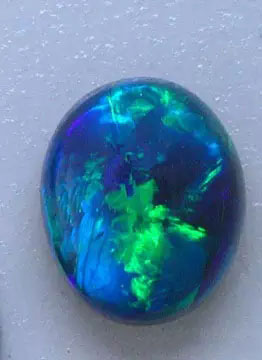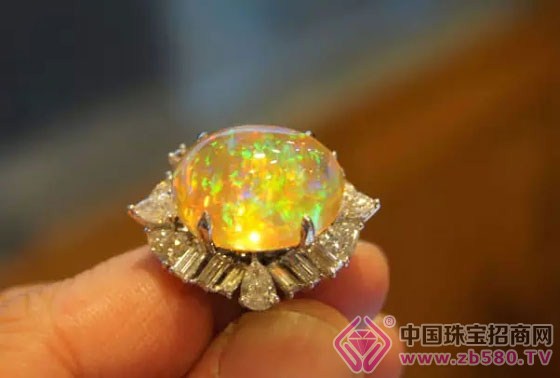Opal's new origin and variety
Opal is Australia's national stone, which is loved by the world for its beautiful and rich color. In Europe, Opal was known as a Roman Empire and was of great value.
Australia is the world's most important opal producer, with major producing areas in New South Wales, South Australia and Queensland. Brazil, the United States, Honduras, Madagascar, New Zealand, Venezuela and other places also have output.
In recent years, some new opal origins and varieties have appeared in the jewelry market, and domestic research institutions have also conducted corresponding research.
I. Peruvian Blue Opal
The Peruvian Acari Blue Opal was discovered during the local mining of copper mines in the early 1980s. At the Tussang Jewelry Fair in the spring of 2001, Peruvian Blue Opal became one of the best-selling gemstone varieties.
The color of the Peruvian blue opal is green blue or blue-green, the color is not developed, transparent-translucent, half-shell-like fracture. Under orthogonal polarized light, the blue opal is integrated with the extinction, and the irregular texture or band extinction is seen locally. Under the short-wave UV lamp, the medium-weak green fluorescence is emitted; under the long-wave UV lamp, the weak green fluorescence is emitted. The interior of the blue opal often contains moss-like, flocculent, spotted iron-manganese oxide and limonite solid inclusions, and occasionally cyanite.

Peruvian Blue Opal
The main chemical component of Peruvian Blue Opal is SiO 2 and contains trace amounts of chemical elements such as Mn, K, Al, Cu and Ca. The main mineral components in blue opal are amorphous globular opals, the secondary minerals are dendritic α-cristobalite and α-tridymite; at high temperatures (11OO ° C), amorphous opal in blue opal , α-cristobalite and α-scaly quartz homogenous thermal phase change into β-scale quartz and β-cristobalite.
Second, Brazil Green Opal
It is reported that the Green Opal is mainly from the Brejinho mining area in Bahia, northeastern Brazil. Since the appearance of this type of opal, it has quickly attracted the attention of many consumers with its colorful and high transparency.
The color-changing effect of Brazilian green opal is not obvious. The main body color is green-yellow-green, uneven distribution, near-transparent-sub-transparent, glass luster; under the polarizer, there is more collective extinction, and local visible plaque abnormal extinction; Under the short-wave ultraviolet light, the breakage of the Brazilian green opal sample is semi-shell-shaped to uneven, and the interior contains dotted, irregular agglomerate, mesh-like gray-white inclusions. Locally visible punctate, moss-like gray-black ferromanganese mineral inclusions, the irregular texture inside the sample is more developed; under the orthogonal polarizing microscope, the Brazilian green opal sample is irregularly micelle-like structure, partially weak Orientation, occasionally microwave texture.
The main mineral composition of Brazilian green opal is opal and contains unequal amounts of minor minerals such as α-cristobalite and a-tridymite. The α-cristobalite and α-scale quartz have an irregular micelle structure as a whole, and local microwave texture develops.
Third, Ethiopian Opal
In 2010, after the opal was extensively mined in the WOLLO region of Ethiopia, the opal in this mining area entered the world's jewelry market in large quantities, and the market demand for it continued to increase. The area is rich in opal varieties, mainly white opal, water opal and light yellow, orange red and brown red fire opal, as well as a few chocolate opal, most of which are obvious in white opal fire, common Large red and orange color, and some special color change, such as part of white opal and fire opal can be seen similar to synthetic opal "lizard skin" structure color change, very few white opal can see special point diffraction Spotted and curved rainbow-like diffractive stains. Ethiopia can be used as a major producer of opals in addition to Mexico and Australia. However, the Ethiopian fire opal and water opal are unstable, and it is easy to form more cracks due to changes in external temperature or moisture, and even crack into small pieces, which seriously affects its stability and processing performance.
Although the Ethiopian Opal has a low yield, it does not need to be made into two or three layers of stone compared to the Australian Opal, and it can be completely ground into a pure natural gemstone without entrainment.

Fire Retardant Non Woven Fabrics
Non Woven Material,Fire Non Woven Fabrics,Fire Retardant Non Woven Fabrics,Fire Retardant Commercial Fabrics
Yizheng fengyisheng nonwoven co., ltd. , https://www.fys-nonwoven.com